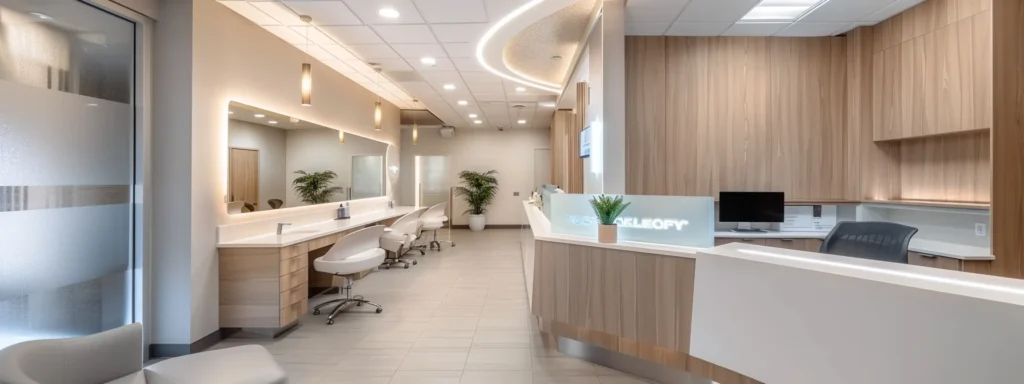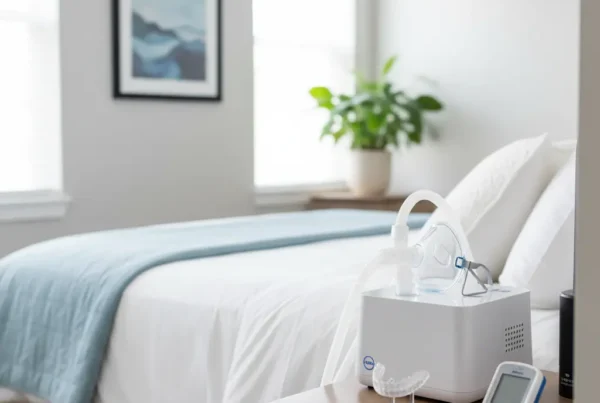Surgical interventions for sleep apnea become essential when conservative treatments like CPAP therapy fail or prove unsuitable for patients. Dr. Chris Cappetta’s 35+ years of dental experience and understanding of airway anatomy help patients understand when surgical consultation might be appropriate and what factors specialists consider when evaluating surgical candidacy.
Understanding When Surgery Becomes Necessary
Sleep apnea surgery becomes a consideration when first-line treatments like CPAP therapy fail to provide adequate symptom relief or prove intolerable for patients. Understanding the limitations of conservative treatments helps patients recognize when surgical consultation might be appropriate. Dr. Chris Cappetta’s 35 years of dental experience and knowledge of airway anatomy provide valuable insights into when surgical options merit discussion.
CPAP machines represent the gold standard for moderate to severe sleep apnea treatment but face significant compliance challenges. Studies show that 30-50% of patients struggle with CPAP adherence due to discomfort, claustrophobia, or lifestyle incompatibility. When these barriers prevent effective treatment, alternative approaches become necessary.
The severity of sleep apnea and associated health risks influence surgical consideration timing. Patients with severe sleep apnea who cannot tolerate CPAP face increased risks for cardiovascular disease, stroke, and other serious complications. These health threats often justify more aggressive treatment approaches.
Our San Antonio clinic regularly educates patients about the spectrum of sleep apnea treatments, from conservative approaches to surgical interventions. Dr. Cappetta’s understanding of oral and facial anatomy helps patients understand how anatomical factors influence treatment success and when specialized surgical evaluation might be beneficial.
Comprehensive Diagnostic Evaluation for Surgical Candidates
Accurate diagnosis forms the foundation of appropriate surgical candidate selection. Sleep studies provide essential objective data about breathing disruption frequency, oxygen saturation levels, and sleep architecture. This information guides healthcare providers in determining treatment urgency and approach selection.
Advanced diagnostic tools like drug-induced sleep endoscopy allow specialists to visualize dynamic airway collapse patterns during sleep-like states. These sophisticated evaluations help identify specific anatomical sites contributing to airway obstruction, enabling targeted surgical planning.
Key diagnostic elements for surgical evaluation include:
- Comprehensive sleep study analysis with detailed breathing measurements
- Physical examination of nasal passages, throat, and jaw structure
- Advanced imaging studies to assess airway anatomy
- Drug-induced sleep endoscopy for dynamic obstruction evaluation
- Medical history review including previous treatment responses
Individual patient anatomy significantly influences surgical candidacy and approach selection. Factors like tongue size, soft palate position, jaw structure, and nasal passage configuration all affect treatment options. Understanding these anatomical variations helps predict surgical success rates.
Previous treatment responses provide crucial information for surgical planning. Patients who have failed multiple conservative treatments may be better surgical candidates than those who haven’t attempted other approaches. This treatment history helps specialists select the most appropriate interventions.
Health Risks of Untreated Sleep Apnea
Untreated sleep apnea poses serious long-term health risks that often justify more aggressive treatment approaches when conservative methods fail. Cardiovascular complications represent the most significant threats, including increased risks for hypertension, heart attack, stroke, and irregular heart rhythms.
Neurological consequences of chronic oxygen deprivation during sleep include cognitive impairment, memory problems, and increased dementia risk. These brain health effects often motivate patients to pursue surgical options when other treatments prove inadequate.
Metabolic disorders frequently accompany untreated sleep apnea, including insulin resistance, type 2 diabetes, and weight gain. The disrupted sleep patterns and hormonal changes associated with sleep apnea contribute to these metabolic complications.
Serious health risks of untreated sleep apnea include:
- Increased cardiovascular disease and stroke risk
- Cognitive decline and memory impairment
- Metabolic disorders including diabetes
- Increased accident risk due to daytime sleepiness
- Reduced quality of life and relationship problems
The compounding nature of these health risks often creates urgency for effective treatment. When CPAP therapy fails and health risks continue accumulating, surgical intervention may become the most appropriate option for preventing serious complications.
Types of Sleep Apnea Surgery
Multiple surgical approaches address different anatomical causes of sleep apnea obstruction. Upper airway procedures focus on removing or repositioning tissues that block breathing during sleep. The specific procedure depends on obstruction location and patient anatomy.
Nasal surgeries address breathing obstructions in the nose and sinuses that contribute to sleep apnea severity. Procedures like septoplasty correct deviated septums while turbinate reduction addresses enlarged nasal tissues. These interventions often improve overall treatment effectiveness.
Soft tissue procedures target the throat and tongue areas where most obstructive events occur. Uvulopalatopharyngoplasty (UPPP) removes excess throat tissue while tongue-based procedures address tongue size or position issues that contribute to airway collapse.
Common surgical approaches include:
- Nasal procedures for breathing obstruction correction
- Soft tissue removal or repositioning in throat areas
- Jaw advancement surgeries for severe cases
- Upper airway stimulation device implantation
- Combination procedures addressing multiple obstruction sites
Maxillomandibular advancement represents the most comprehensive surgical approach, repositioning both upper and lower jaws to enlarge the airway. This complex procedure offers high success rates but requires significant recovery time and careful patient selection.
Upper airway stimulation involves implanting a device that stimulates throat muscles during sleep to prevent airway collapse. This newer technology offers an alternative to traditional tissue removal procedures for appropriately selected patients.
Patient Selection Criteria
Surgical candidacy depends on multiple factors including sleep apnea severity, anatomical considerations, previous treatment failures, and overall health status. Not all patients are appropriate surgical candidates, making careful evaluation essential for optimal outcomes.
CPAP failure or intolerance often represents the primary indication for surgical consultation. However, failure must be clearly documented through adequate CPAP trials with proper equipment fitting and patient education. True CPAP failure differs from insufficient attempts or poor equipment selection.
Anatomical factors significantly influence surgical success rates and approach selection. Patients with specific obstruction patterns may be better surgical candidates than those with complex, multi-level obstructions. Advanced imaging and endoscopic evaluation help identify optimal candidates.
Key surgical candidacy factors include:
- Documented CPAP failure or intolerance
- Appropriate anatomical features for surgical correction
- Adequate overall health status for surgery and recovery
- Realistic expectations about outcomes and recovery
- Commitment to post-operative care and follow-up
Age and overall health status influence surgical risk and recovery potential. Younger, healthier patients generally experience better outcomes and fewer complications. However, age alone doesn’t disqualify patients from surgical consideration when other factors are favorable.

Surgical Risks and Benefits
Sleep apnea surgery, like all surgical procedures, involves both potential benefits and risks that patients must understand before making treatment decisions. Success rates vary depending on procedure type, patient selection, and surgeon experience. Understanding these factors helps patients make informed choices.
Potential surgical benefits include improved sleep quality, reduced daytime sleepiness, and decreased long-term health risks associated with untreated sleep apnea. Many patients experience significant quality of life improvements when surgery successfully addresses their breathing obstructions.
Surgical risks vary by procedure but may include bleeding, infection, changes in voice or swallowing, and incomplete symptom resolution. More complex procedures generally carry higher risks but may offer greater benefits for appropriate candidates.
Common surgical considerations include:
- Procedure-specific success rates and risk profiles
- Recovery time requirements and activity restrictions
- Potential need for additional procedures or treatments
- Long-term maintenance and follow-up requirements
- Cost considerations and insurance coverage
Recovery experiences vary significantly between procedure types and individual patients. Minimally invasive procedures may require only days of recovery while complex jaw surgeries may need weeks or months. Understanding recovery expectations helps patients plan appropriately.
Multidisciplinary Approach to Treatment
Sleep apnea surgery works best within a comprehensive, multidisciplinary treatment approach involving sleep medicine specialists, surgeons, and other healthcare providers. This collaborative model ensures all aspects of the condition receive appropriate attention and treatment.
Team-based care allows for comprehensive evaluation of surgical candidacy and optimal procedure selection. Each specialist contributes their expertise to create individualized treatment plans that address patient-specific factors and maximize success potential.
Dr. Cappetta’s dental expertise provides valuable insights into oral and facial anatomy factors that influence surgical outcomes. His 35 years of experience helps patients understand how dental and facial structures relate to sleep-disordered breathing and surgical treatment approaches.
Our San Antonio clinic emphasizes the importance of coordinated care between dental and medical specialists for optimal sleep apnea management. This collaborative approach ensures patients receive comprehensive evaluation and appropriate treatment recommendations.
Post-Surgical Care and Long-Term Management
Successful sleep apnea surgery requires comprehensive post-operative care and long-term follow-up to ensure optimal outcomes and identify any complications early. Recovery protocols vary by procedure but generally include activity restrictions, pain management, and gradual return to normal activities.
Follow-up sleep studies typically occur several months after surgery to objectively assess treatment effectiveness. These studies determine whether additional treatments are necessary and help optimize long-term management strategies.
Post-surgical care elements include:
- Immediate recovery monitoring and pain management
- Activity restrictions and gradual activity resumption
- Follow-up appointments for healing assessment
- Repeat sleep studies to measure treatment effectiveness
- Long-term monitoring for continued symptom control
Some patients may require additional treatments even after successful surgery. Weight management, positional therapy, or other interventions may enhance surgical results and provide optimal long-term symptom control.
Alternative and Complementary Approaches
Understanding the full spectrum of sleep apnea treatments helps patients make informed decisions about surgical timing and appropriateness. Conservative approaches should generally be attempted before surgical consideration unless specific circumstances warrant more aggressive initial treatment.
Oral appliance therapy represents an important middle-ground option between CPAP and surgery for many patients. These devices may be effective alone or in combination with surgical procedures to optimize treatment outcomes.
Lifestyle modifications including weight management, positional therapy, and sleep hygiene improvements support all sleep apnea treatments and may reduce the need for more aggressive interventions. These approaches work synergistically with surgical treatments.
Dr. Cappetta’s understanding of comprehensive sleep apnea management helps patients understand how different treatments complement each other and when surgical consultation might be most appropriate within the broader treatment spectrum.
Making Informed Surgical Decisions
Sleep apnea surgery represents a significant treatment option when conservative approaches fail or prove inadequate for managing this serious condition. Dr. Chris Cappetta’s 35 years of dental experience and understanding of airway anatomy provide valuable educational resources for patients considering surgical consultation. When surgical intervention is appropriate, Dr. Cappetta works with a network of qualified surgical specialists to ensure patients receive expert care.
Our San Antonio clinic has educated countless patients about the comprehensive approach to sleep apnea management, including when surgical options merit consideration. Dr. Cappetta’s role involves helping patients understand surgical candidacy factors and coordinating referrals to experienced sleep apnea surgeons when appropriate. This collaborative approach ensures patients receive specialized care for complex procedures.
Don’t let untreated sleep apnea continue compromising your health when effective treatment options are available. Contact Fountain of Youth Dental today to schedule your comprehensive sleep apnea consultation. Together with Dr. Cappetta, we’ll help you understand all treatment options and coordinate appropriate referrals if surgical evaluation becomes necessary for your specific situation.
See More Reviews From Fountain of Youth Dental. View information about local places in our community.
Schedule Your Free Consultation Today!
Fountain of Youth Dental
5282 Medical Dr. #520 San Antonio, TX 78229 (210) 614-5481 Driving Directions
Frequently Asked Questions
When is surgery considered for sleep apnea?
Surgery is considered when conservative treatments like CPAP therapy have failed or proven intolerable, and sleep apnea continues posing health risks. The decision depends on factors including severity, anatomy, previous treatment responses, and overall health status.
What surgical options are available for sleep apnea?
Multiple surgical approaches address different anatomical causes of sleep apnea, ranging from minimally invasive nasal procedures to complex jaw advancement surgeries. The best option depends on obstruction location, severity, and individual patient factors.
Is sleep apnea surgery safe and effective?
Sleep apnea surgery can be safe and effective when performed by experienced surgeons on appropriately selected patients. Success rates vary by procedure type and patient factors, with careful evaluation essential for optimal outcomes and minimized risks.





